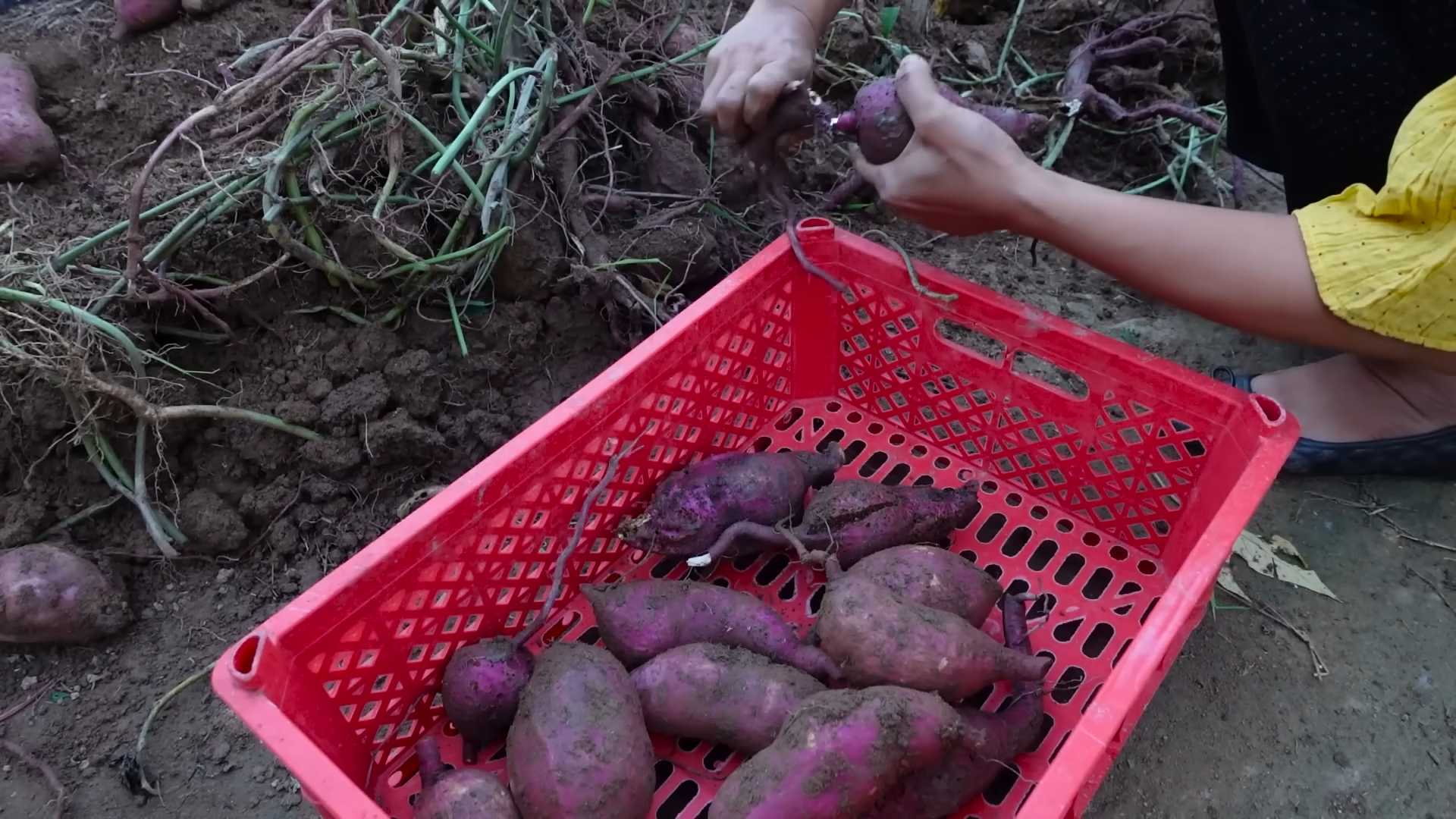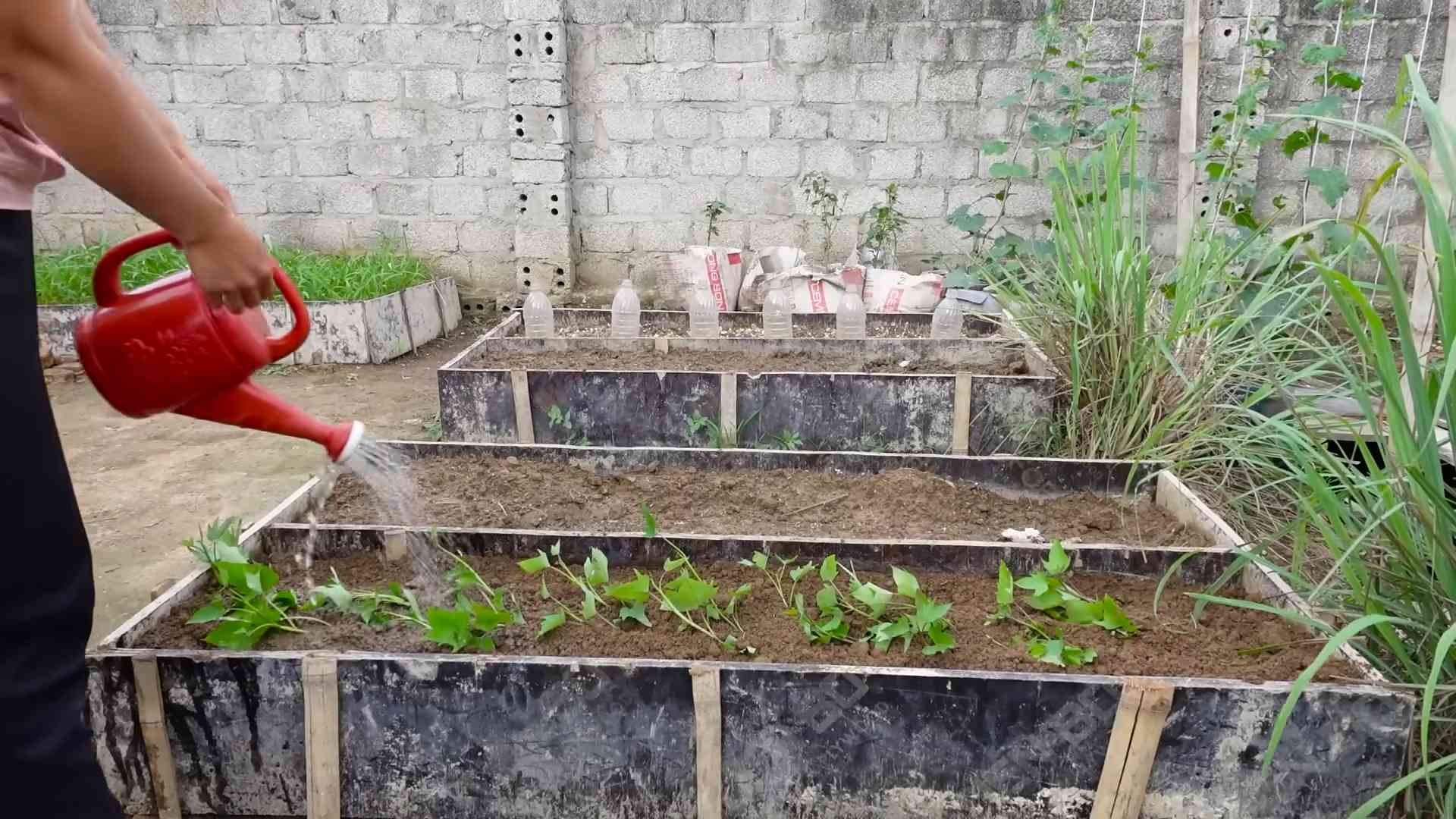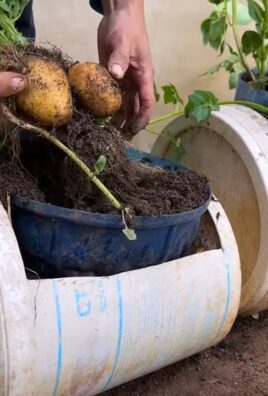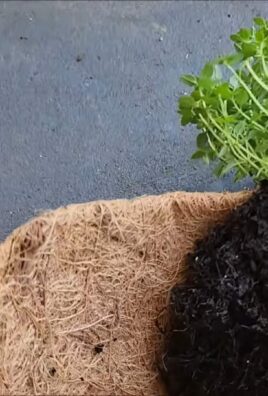Grow Sweet Potatoes Home – sounds like a dream, right? Imagine harvesting your own vibrant, nutrient-packed sweet potatoes right from your backyard! It’s more achievable than you think, and this DIY guide is your passport to a bountiful sweet potato harvest. Forget those bland, store-bought spuds; we’re diving into the world of homegrown goodness!
Sweet potatoes have a rich history, dating back thousands of years in Central and South America. They were a staple food for indigenous populations and eventually spread across the globe, becoming a beloved ingredient in countless cuisines. Today, growing your own sweet potatoes connects you to that history, offering a taste of tradition and self-sufficiency.
But why should you bother with growing your own? Well, for starters, the flavor is unmatched! Freshly harvested sweet potatoes are sweeter and more flavorful than anything you’ll find in the supermarket. Plus, you control the growing process, ensuring they’re free from harmful pesticides and chemicals. This DIY project is perfect for anyone looking to embrace a more sustainable lifestyle, save money on groceries, and enjoy the satisfaction of nurturing your own food. I’m excited to share these simple yet effective tricks and hacks that will help you grow sweet potatoes home successfully, even if you’re a beginner gardener. Let’s get started!

Growing Sweet Potatoes at Home: A Comprehensive DIY Guide
Hey there, fellow gardening enthusiasts! I’m so excited to share my experience and guide you through growing your own sweet potatoes right at home. It’s surprisingly rewarding, and nothing beats the taste of homegrown sweet potatoes. Let’s dive in!
Choosing Your Sweet Potato Variety
First things first, you need to decide which sweet potato variety you want to grow. There are tons of options, each with its own unique flavor, color, and growing characteristics. Here are a few popular choices:
* Beauregard: This is a classic, reliable variety with reddish-purple skin and orange flesh. It’s known for its consistent yields and sweet flavor.
* Jewel: Another popular choice, Jewel sweet potatoes have copper-colored skin and deep orange flesh. They’re also quite sweet and store well.
* Garnet: Garnet sweet potatoes have deep red skin and vibrant orange flesh. They’re slightly less sweet than Beauregard or Jewel, but still delicious.
* Japanese Sweet Potato (Muraski): If you’re looking for something different, try Japanese sweet potatoes. They have purple skin and white flesh that turns golden when cooked. They’re known for their nutty flavor.
* Okinawan Sweet Potato: Another purple-skinned variety, Okinawan sweet potatoes have purple flesh and a slightly drier texture than other varieties.
Once you’ve chosen your variety, you’re ready to get started!
Sprouting Your Sweet Potatoes: Creating Slips
Sweet potatoes don’t grow directly from seeds. Instead, you need to grow “slips,” which are sprouts that emerge from the sweet potato itself. Here’s how to do it:
1. Choose a Healthy Sweet Potato: Select a firm, healthy sweet potato from your chosen variety. Avoid any with soft spots or blemishes. Organic sweet potatoes are best, as they haven’t been treated to prevent sprouting.
2. Prepare Your Sprouting Container: You have two main options here:
* Water Method: Suspend the sweet potato in a jar or glass of water, with the bottom half submerged. You can use toothpicks to hold it in place.
* Soil Method: Bury the sweet potato horizontally in a container filled with moist potting mix, leaving the top slightly exposed.
3. Provide Warmth and Light: Place your sprouting container in a warm, sunny location. A temperature of around 75-85°F (24-29°C) is ideal.
4. Maintain Moisture: If using the water method, change the water every few days. If using the soil method, keep the soil consistently moist but not soggy.
5. Wait Patiently: It can take several weeks for slips to emerge. Be patient! You’ll start to see small sprouts appear from the sweet potato’s “eyes.”
6. Harvesting the Slips: Once the slips are 6-8 inches long, they’re ready to be harvested. Gently twist or cut them off the sweet potato, being careful not to damage the remaining sprouts.
7. Rooting the Slips (Optional but Recommended): Place the harvested slips in a glass of water, with the bottom inch or two submerged. This will encourage them to develop roots before planting. Change the water every few days.
Preparing Your Garden Bed
Sweet potatoes need plenty of space and well-drained soil to thrive. Here’s how to prepare your garden bed:
1. Choose a Sunny Location: Sweet potatoes need at least 6-8 hours of direct sunlight per day.
2. Prepare the Soil: Sweet potatoes prefer loose, sandy loam soil. If your soil is heavy clay, amend it with compost, aged manure, or other organic matter to improve drainage.
3. Create Raised Beds (Optional but Recommended): Raised beds help improve drainage and warm the soil, which is beneficial for sweet potato growth.
4. Fertilize the Soil: Sweet potatoes don’t need a lot of fertilizer, but a light application of a balanced fertilizer (e.g., 10-10-10) can help get them off to a good start. Avoid using fertilizers high in nitrogen, as this can promote excessive vine growth at the expense of tuber development.
5. Space Your Plants: Sweet potatoes need plenty of room to spread out. Space your plants 12-18 inches apart in rows that are 3-4 feet apart.
Planting Your Sweet Potato Slips
Now comes the fun part – planting your sweet potato slips!
1. Water the Soil: Before planting, thoroughly water the soil in your prepared garden bed.
2. Dig Holes: Dig holes that are deep enough to accommodate the roots of your slips.
3. Plant the Slips: Gently place each slip in a hole, burying the roots and the bottom portion of the stem. Leave the top leaves exposed.
4. Water Again: Water the newly planted slips thoroughly to help them settle in.
5. Mulch (Optional): Mulching around your sweet potato plants can help retain moisture, suppress weeds, and regulate soil temperature. Use organic mulch such as straw, hay, or shredded leaves.
Caring for Your Sweet Potato Plants
Once your sweet potato plants are in the ground, here’s how to keep them happy and healthy:
1. Water Regularly: Sweet potatoes need consistent moisture, especially during the first few weeks after planting. Water deeply whenever the soil feels dry to the touch.
2. Weed Regularly: Keep your garden bed free of weeds, which can compete with your sweet potato plants for nutrients and water.
3. Control Pests and Diseases: Sweet potatoes are generally pest-resistant, but they can be susceptible to certain pests and diseases, such as sweet potato weevils and fungal diseases. Inspect your plants regularly and take action if you notice any problems. Organic pest control methods, such as insecticidal soap or neem oil, can be effective.
4. Vine Training (Optional): Sweet potato vines can spread quite a bit. If you have limited space, you can train them to grow up a trellis or fence.
5. Avoid Over-Fertilizing: As mentioned earlier, sweet potatoes don’t need a lot of fertilizer. Over-fertilizing can lead to excessive vine growth and reduced tuber production.
Harvesting Your Sweet Potatoes
The moment you’ve been waiting for! Here’s how to harvest your sweet potatoes:
1. Timing is Key: Sweet potatoes are typically ready to harvest about 90-120 days after planting. The best time to harvest is before the first frost in your area.
2. Check for Maturity: You can check for maturity by digging up a test sweet potato. If it’s a good size and has a well-developed skin, it’s likely that the rest of your crop is ready to harvest.
3. Dig Carefully: Use a garden fork or shovel to carefully dig around the sweet potato plants, being careful not to damage the tubers.
4. Lift the Plants: Gently lift the plants from the ground, and brush off any excess soil.
5. Curing Your Sweet Potatoes: Curing is an essential step in the sweet potato harvesting process. It allows the skins to harden and the starches to convert to sugars, resulting in a sweeter, more flavorful sweet potato.
* Clean the Sweet Potatoes: Gently brush off any remaining soil from the sweet potatoes. Avoid washing them, as this can promote rot.
* Curing Environment: Place the sweet potatoes in a warm, humid location (80-85°F/27-29°C and 85-90% humidity) for 7-10 days. A greenhouse, garage, or shed can work well.
* Proper Air Circulation: Ensure good air circulation around the sweet potatoes to prevent mold growth.
* Monitor for Rot: Check the sweet potatoes regularly for signs of rot. Discard any that are damaged or diseased.
6. Storing Your Sweet Potatoes: After curing, store your sweet potatoes in a cool, dry, and dark place (55-60°F/13-16°C). They should keep for several months.
Troubleshooting Common Issues
Even with the best care, you might encounter some challenges along the way. Here are a few common issues and how to address them:
* Slips Not Sprouting: Make sure your sweet potato is in a warm, sunny location and that the water or soil is consistently moist. Sometimes, it just takes time.
* Yellowing Leaves: Yellowing leaves can indicate a nutrient deficiency. Try applying a balanced fertilizer.
* Pest Problems: Inspect your plants regularly for pests and take action as needed. Organic pest control methods are often effective.
* Rotting Sweet Potatoes: Rotting sweet potatoes can be caused by overwatering or poor drainage. Make sure your

Conclusion
So, there you have it! Growing sweet potatoes at home is not only achievable, but it’s also a deeply rewarding experience. Forget those bland, store-bought sweet potatoes; imagine sinking your teeth into a homegrown sweet potato, bursting with flavor and packed with nutrients. This DIY trick transforms your kitchen into a mini-farm, offering a sustainable and delicious alternative to relying solely on grocery stores.
Why is this a must-try? Because it’s more than just growing food; it’s about connecting with nature, understanding the life cycle of plants, and enjoying the fruits (or rather, tubers!) of your labor. It’s about reducing your carbon footprint by sourcing food locally, even if “local” means your own backyard or balcony. And let’s be honest, there’s a certain satisfaction that comes from nurturing a plant from a simple slip to a bountiful harvest.
But the beauty of this DIY project lies in its adaptability. Feel free to experiment with different varieties of sweet potatoes. Beauregard, with its vibrant orange flesh, is a classic choice, but why not try Japanese sweet potatoes with their purple skin and creamy white interior? Or perhaps the Covington variety, known for its disease resistance and high yields?
Consider different growing mediums as well. While we’ve focused on using water to sprout the slips, you can also try starting them directly in soil. Just ensure the soil is well-draining and kept consistently moist. For those with limited space, container gardening is an excellent option. Choose a large pot or container with drainage holes and fill it with a well-draining potting mix.
Don’t be afraid to get creative with your setup. Repurpose old containers, build a simple trellis for the vines to climb, or even create a vertical garden to maximize space. The possibilities are endless!
And remember, growing sweet potatoes at home is a learning process. Don’t be discouraged if your first attempt isn’t perfect. Every mistake is an opportunity to learn and improve. Pay attention to the needs of your plants, adjust your approach as needed, and most importantly, have fun!
We wholeheartedly encourage you to try this DIY trick for growing sweet potatoes at home. It’s a simple, sustainable, and satisfying way to enjoy fresh, delicious produce. Once you’ve harvested your first crop, we’d love to hear about your experience. Share your photos, tips, and stories in the comments below. Let’s build a community of home gardeners and inspire others to embrace the joy of growing their own food. Let us know what challenges you faced and what worked best for you. Your insights could be invaluable to other aspiring sweet potato growers. So, get your sweet potatoes ready, grab your supplies, and let’s get growing!
Frequently Asked Questions (FAQ)
Q: What kind of sweet potato should I use to start the slips?
A: You can use any sweet potato you find at the grocery store, but organic sweet potatoes are generally recommended. Non-organic sweet potatoes may be treated with growth inhibitors to prevent sprouting, which can hinder the slip-growing process. Look for sweet potatoes that are firm, free of blemishes, and haven’t started to sprout already. If you have access to sweet potatoes from a local farmer or garden, those are often the best choice. Experiment with different varieties to see which ones thrive best in your environment and which flavors you prefer.
Q: How long does it take for sweet potato slips to grow?
A: The time it takes for sweet potato slips to grow varies depending on several factors, including the variety of sweet potato, the temperature, and the amount of light they receive. Generally, you can expect to see slips emerging within 2-4 weeks. Once the slips are about 6-8 inches long, they are ready to be transplanted into soil. Be patient and provide consistent moisture and warmth to encourage healthy slip development.
Q: What kind of soil is best for growing sweet potatoes?
A: Sweet potatoes prefer well-draining, sandy loam soil. This type of soil allows the tubers to expand easily without becoming waterlogged. If your soil is heavy clay, amend it with compost, sand, and other organic matter to improve drainage and aeration. The ideal soil pH for sweet potatoes is between 5.5 and 6.5. Before planting, consider getting a soil test to determine the pH and nutrient levels of your soil. Amend the soil as needed based on the test results.
Q: How much sunlight do sweet potatoes need?
A: Sweet potatoes need at least 6-8 hours of direct sunlight per day to thrive. Choose a planting location that receives plenty of sunlight throughout the day. If you are growing sweet potatoes in containers, you can move them around to ensure they get adequate sunlight. Insufficient sunlight can result in smaller tubers and reduced yields.
Q: How often should I water sweet potatoes?
A: Water sweet potatoes regularly, especially during dry periods. Keep the soil consistently moist, but avoid overwatering, which can lead to root rot. Water deeply when the top inch of soil feels dry to the touch. During hot weather, you may need to water more frequently. Mulching around the plants can help retain moisture in the soil and reduce the need for frequent watering.
Q: What are some common pests and diseases that affect sweet potatoes?
A: Some common pests that can affect sweet potatoes include sweet potato weevils, flea beetles, and aphids. Diseases that can affect sweet potatoes include stem rot, black rot, and scurf. Monitor your plants regularly for signs of pests or diseases. Use organic pest control methods, such as insecticidal soap or neem oil, to control pests. Practice crop rotation and choose disease-resistant varieties to prevent diseases.
Q: When is the best time to harvest sweet potatoes?
A: Sweet potatoes are typically ready to harvest about 90-120 days after planting the slips. The best time to harvest is before the first frost. The leaves will start to turn yellow and the vines will begin to die back, indicating that the tubers are mature. Gently dig around the plants to avoid damaging the tubers. Cure the sweet potatoes for 7-10 days in a warm, humid place to allow the skins to harden and the starches to convert to sugars.
Q: Can I grow sweet potatoes in containers?
A: Yes, you can successfully grow sweet potatoes in containers. Choose a large container with drainage holes, at least 20 gallons in size. Fill the container with a well-draining potting mix. Plant the slips in the container and provide them with plenty of sunlight and water. Container-grown sweet potatoes may not produce as many tubers as those grown in the ground, but you can still harvest a decent crop.
Q: How do I store sweet potatoes after harvesting?
A: After curing the sweet potatoes, store them in a cool, dark, and dry place with good ventilation. The ideal storage temperature is between 55-60°F (13-16°C). Avoid storing sweet potatoes in the refrigerator, as this can cause them to develop a hard core and lose flavor. Properly stored sweet potatoes can last for several months.
Q: Can I eat the leaves of the sweet potato plant?
A: Yes, the leaves of the sweet potato plant are edible and nutritious. They can be eaten raw in salads or cooked like spinach. Choose young, tender leaves for the best flavor and texture. Sweet potato leaves are a good source of vitamins, minerals, and antioxidants.




Leave a Comment